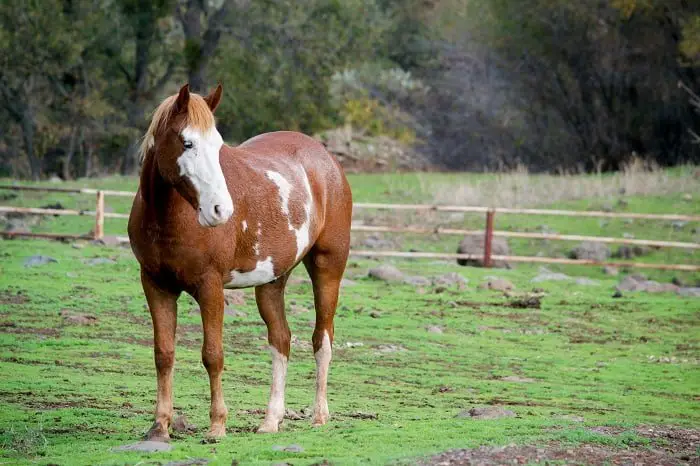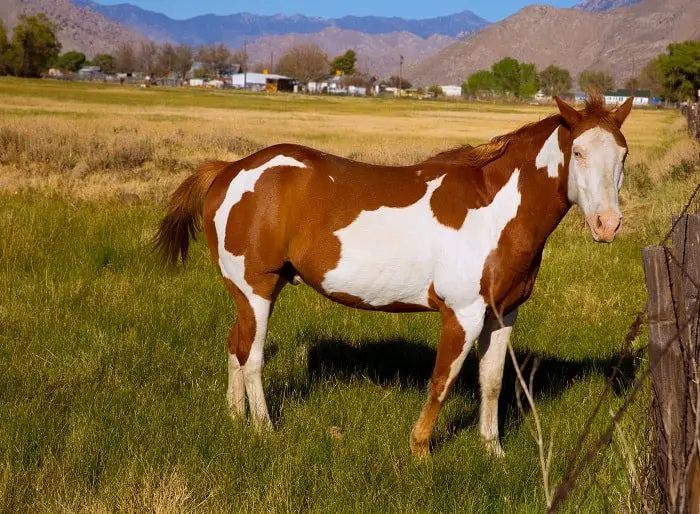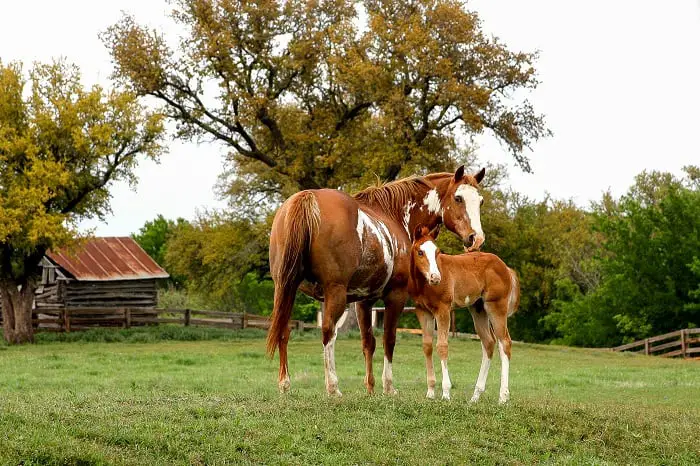Last Updated on April 2, 2023
There are several different types of Paint horses, and it can be confusing trying to work out which is which. Add into this all the unusual names for the various types of Paint horses, and you’ll be even more baffled!
Do you have an interest in horse breeds, pedigrees, and how they get their coloring? Have you ever heard people talk about their Paint or pinto horses, but don’t understand the difference? Despite the amazing similarities in coloration, pinto and Paint horses are not the same things, although many people get them mixed up.
Whether you’re in the market for a new horse, surrounded by horse fanatics, or merely interested in horse genetics, being knowledgeable about the different types of Paint horses may be helpful to you.
Today we’ll find out what exactly a Paint horse is, and the different types of markings you will find on these beautiful horses!
What is a Paint Horse?
In the horse world, it is all too common to get horse colors and breeds muddled up. Two common examples are the palomino – which is a color, not a breed – and the Appaloosa – which is a breed, not a color!
Paint horses are instantly recognized for their unusual coat patterns, normally a combination of white and any other coat color. However, even though they are recognized for their coat coloring, they are actually a breed of horse.
The American Paint Horse Association (APHA) says that “Paint horses are unique… because of their spotted coat patterns. Even though their base coats are the same in color as that of other breeds, nevertheless, superimposed over these colors are a variety of white-spotted patterns.”
However, don’t let this description mislead you into thinking that Paint horses have spots on their coats! The term white-spotted is used to refer to horses with a specific set of genes that create unusual distributions of white hairs on the body. These can be in large or small patches or smaller spots.
Thanks to their Quarter horse and Thoroughbred bloodlines, Paint horses are stocky and powerfully muscled. They are usually between 14.2 and 15.2 hh but can get taller than this.
The Paint horse is known for its amiable nature, making them a good all-around mount and companion. Their good temperament combined with innate intelligence makes them a pleasure to train for various equestrian pursuits and easy to care for at home.
Paint Horse Registration & Genetics
The Paint horse breed has stringent bloodline requirements, and a foal must also meet certain criteria in terms of markings for it to be eligible for registration as a Paint horse. One parent must be registered as a Paint horse with the breed registry. The other parent can also be a registered Paint horse or can be registered with either the Thoroughbred or Quarter horse breed societies. As the Paint horse breed bloodlines are descended from Thoroughbreds and Quarter horses, these rules help to maintain the breed standard.
There are two categories of registration for Paint horses – horses with color, and solid Paint-bred. To be eligible for registration, the parents of solid Paint-bred horses must also both be registered Paint horses. So, you could have a solid chestnut Paint horse that does not have any white markings.
As the different types of Paint horses and their coat patterns can be difficult to identify, many owners choose to have their horses DNA tested to identify which coat pattern genes they carry. This is particularly useful if you want to breed a horse with certain color patterns. It can also help avoid the breeding of foals that can carry color-linked health problems, such as the ‘Lethal White Syndrome’ that can occur in frame overo patterns.
Different Types of Paint Horses – Color Patterns Explained
There are three distinct coat patterns in Paint horses, and each registered horse will fit into one of these categories. Each type of paint horse coat pattern is named after the gene responsible for the distribution of white hair, these are the tobiano, overo, and tovero patterns. There is also a fourth color category, solid, for eligible Paint horses that do not have any white markings.
As well as the color pattern exhibited by the horse, the base coat color is also relevant when describing the appearance of a Paint horse. This color is the shade that will appear on the parts of the body that are not white.
The most common base American Paint horse colors are chestnut (sorrel), black, brown, and bay. You will also come across some Paint horses that carry coat color dilution genes, giving them a base coat color that could be buckskin, palomino, perlino, cremello, champagne, or pearl. Shades of roan or dun are also possible, and some Paint horses carry the grey coat color gene. Horses that have a bay base coat, with or without a dilution gene, are often described as tri-colored paint horses.
Tobiano
The tobiano Paint horse is the most common coat pattern found in this breed. They are characterized by colored hair over the body broken up by splashes of white across the back. The legs will be white, the tail and mane can be either color, and the head is often dark with facial markings such as a blaze, strip, or star.
Overo
To make things more complicated, the overo Paint horse markings are broken up into three subcategories – frame, sabino, and splashed white. Horses with these patterns all tend to have irregular horizontal white markings, with more colored hair than white. The face is normally white, and blue eyes are commonly seen. The white markings do not tend to cross the back, and the limbs are normally colored on the lower half.
- Frame: This coat pattern gets its name from the dark coloring along the topline of the horse, creating a frame along the outline of the body.
- Sabino: These horses have patches of spots or roaning on the upper legs, belly, and face.
- Splashed white: Splash paint horses have clearly defined white blocky markings originating from the belly and extending upwards. The head, legs, and tail will also normally be white.
Tovero
Tovero horses can be difficult to identify, as they have a mix of overo and tobiano coat color patterns. This gives them unusual features such as blue eyes on a dark-colored head.
Solid
As the name suggests, solid-colored Paint horses do not have any white markings. These horses are only eligible for registration if they have two registered Paint parents, and they can then participate in special sections at Paint breed shows. Although these horses do not exhibit white markings, they still have the potential to breed foals with white-spotted coat patterns.
Are Pinto and Paint Horses the Same?
The term pinto is used to describe the coloration of a horse rather than a specific breed. This means that a pinto horse can be any breed or type that has a coat with patches of white and other equine coloration. Loosely speaking, you could describe Paint horses as having pinto coloring, but most Paint horse owners prefer to describe their horses by their specific type of white-spotting pattern markings.
Unusually, horses with pinto markings can also be registered in one of the various pinto color registries. These horses are not registered as any particular breed but instead are classified as a certain type – miniature, pony, horse, and utility. Within these classifications are subcategories such as Mini A, Mini B, Stock, Hunter, Pleasure, Saddle, Gypsy/Vanner, and Drum. This system allows owners of colored horses to register them when they do not fit into any other specific breed registry.
- Stock: Generally, a Quarter Horse or a Paint-type, the stock horse is a western-style horse that is often used for working livestock and barrel racing.
- Hunter: Predominantly Thoroughbred and certain types of European Warmbloods, hunter horses are often used in hunter-jumper competitions for their gait, manners, and jumping style.
- Pleasure: Usually an Arabian, Andalusian, or Morgan, the pleasure horse is often known for its relaxed appearance and pure gaits in Western pleasure riding.
- Saddle: Mostly Saddlebred, Hackney, or Tennessee Walker, the saddle horse is a selectively-bred gaited horse that is known to have ambling gaits resulting in a notoriously smooth ride.
- Miniature: Must measure under 39″ at the wither at maturity for Mini B classification, or under 35″ for Mini A.
- Utility: This group includes Gypsy Cob and Gypsy Vanner type horses, plus Drum horses, which are a Gypsy type crossed with a draft breed.
Conclusion
So, as we have learned, while the term pinto refers to the coloration and pattern of a horse, Paint is a specific breed of horse that often has pinto coloration. Paint horses are descended from Thoroughbred and Quarter Horse bloodlines, while horses with pinto coloring can come from any breed or type of horse.
If you’re interested in learning more about Paint horse colorations and breeding, the APHA provides a detailed list with pictures (page 18).
Leave a comment below if you have any questions or more insight into the different types of Paint horses!
FAQs
Are all paint horses pinto?
Yes! Most Paint horses are pinto, but pinto horses are not always Paint. The term pinto describes the color of a horse, while Paint is a breed of horse.
Paint horses carry specific genes which give them pinto coloring. Pintos have patches of white and any other color, and this is an overarching term for one of many possible patterns rather than the name of one specific Paint horse color pattern.
Do pinto horses always produce pinto offspring?
Pinto horses do not always produce pinto offspring together - it will depend on which coat color genes they carry, and whether they are dominant or not. In order to determine whether a pinto horse will produce pinto offspring, genetic tests can tell you what genes they carry and the likelihood of their offspring also being pinto.
Are pinto horses rare?
In some horse breeds, pinto coloring is extremely rare, and many stud books do not permit the registration of horses with pinto coloring. On the other hand, pinto coloring is very common in some breeds, such as the American Paint horse.
Are paints good horses?
Yes! Paints are one of the most popular paint horse breeds. They have beautiful color markings and are very smart, athletic horses. They combine the traits of Quarter horses and Thoroughbreds to create a mount that is versatile, agile, and very quick to learn.
What is the Paint horse known for?
Paint horses are known for being beautiful, athletic, and intelligent, and they are renowned for their often remarkable coat color patterns. Interestingly, the Paint horse breed came into being when the Quarter horse registry was set up, as they did not permit horses with pinto coloring to be registered. So, fans of Quarter horses with colored markings set up their own breed registry, which became known as the American Paint horse!
Can you register a paint horse without knowing the parents?
Paint horses must be bred from at least one registered Paint parent in order to be registered as Paint, and the other parent must be registered as a Thoroughbred or Quarter horse. This maintains the breed standard and color bloodlines of this magnificent horse breed.
Michael Dehaan is a passionate horse owner, horse rider, and lover of all things equine. He has been around horses since he was a child, and has grown to become an expert in the field. He has owned and ridden a variety of horses of different breeds, and has trained many to compete in shows and competitions. He is an experienced horseman, having worked with and competed many horses, including his own. He is an active member of the equestrian community, participating in events and teaching riding lessons.



